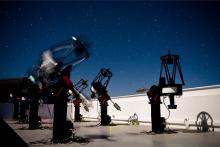The NASA Kepler Mission taught us that Earth-sized planets are a commonplace throughout the Galaxy. But did life take root on any of these distant worlds? Using upcoming large telescopes, astronomers will search the atmospheres of Earth-like planets for the telltale chemical fingerprints of life.
ABOUT THE SPEAKER
Dr. David Charbonneau is a Professor of Astronomy at Harvard University. Dr. Charbonneau's research focuses on the detection and characterization of exoplanets with the goal of studying inhabited worlds. He led the team that made the first detection of the passage of an exoplanet across its parent star; the first detection of an exoplanet atmosphere; and the first detection of light emitted by a planet outside the solar system. Using data from the NASA Kepler Mission, Dr. Charbonneau and his student Courtney Dressing determined the Galactic frequency of occurrence of planets that were similar to Earth in both size and temperature. He currently leads the MEarth Project, which has found several of the terrestrial exoplanets whose atmospheres are amenable to study, and he is a Co-Investigator on the NASA TESS Mission, which launched in April 2018. Dr. Charbonneau has received numerous awards for his research, including the Alan T. Waterman Award from the NSF and the Medal for Exceptional Scientific Achievement from NASA, and is a member of the National Academy of Sciences. He earned his Ph.D. in Astronomy from Harvard University, and his B.Sc. in Math, Physics, and Astronomy from the University of Toronto.
